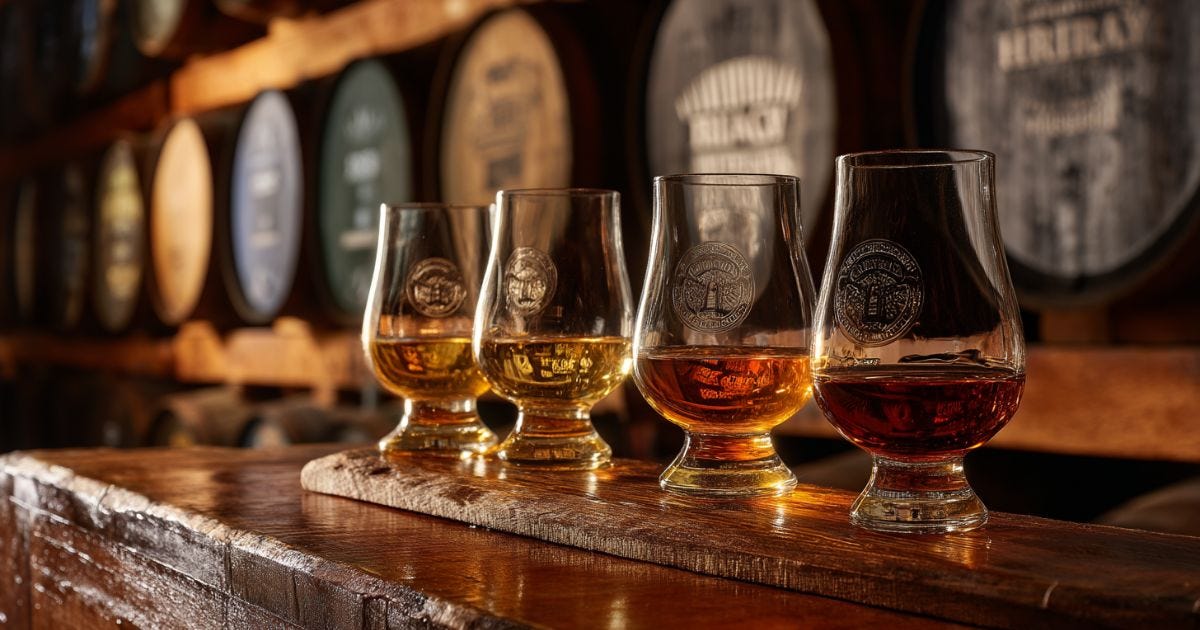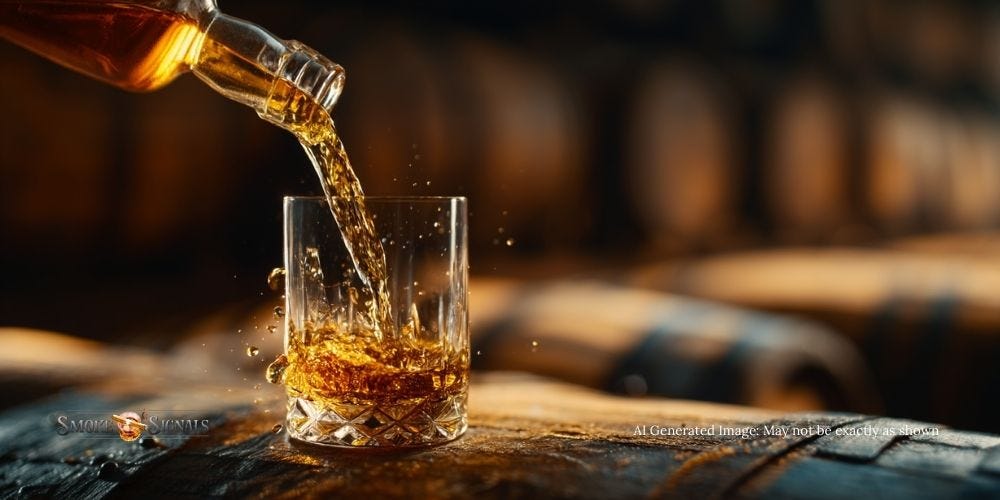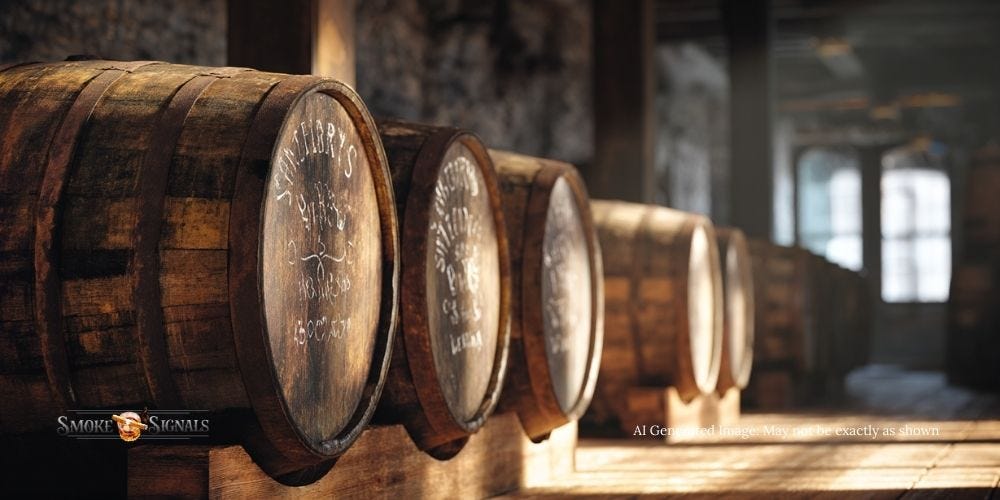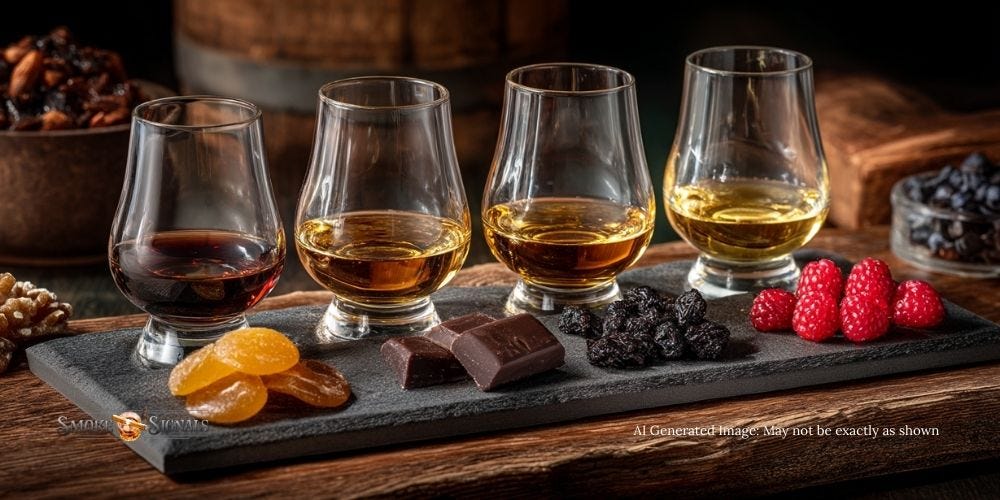Cask Finished Whiskey: How Different Barrels Influence Flavor
Discover how sherry, port, rum, and other cask finishes transform whiskey’s character — and the perfect cigars to match.

Listen While You Read 🎧
Hit play and let the audio set the mood while you explore the rich world of cask finished whiskey — where each barrel tells a different story in your glass.
Cask-Finished Whiskey: How Different Barrels Influence Flavor (and Pair with Cigars)
Summary:
In the world of whiskey, cask finishing is where artistry meets alchemy. By moving a mature spirit into a second barrel — often one that once held sherry, port, rum, or even wine — distillers can unlock layers of flavor that transform the whiskey’s personality. For cigar lovers, these finishes open up an entirely new playground for pairing, where the right smoke can elevate every sip.
🔥 Key Takeaways
🥃 Cask finishing is a secondary maturation process that adds complexity, depth, and distinctive character to whiskey.
🍷 Popular finishes include sherry, port, rum, Sauternes, Mizunara oak, and even beer or brandy casks.
👃 Each cask type influences the aroma, taste, and mouthfeel in unique ways.
💨 Pairing tip: Bold finishes shine with full-bodied cigars; lighter finishes work beautifully with milder smokes.
🚀 Industry trends are leaning toward experimental and collaborative cask projects from both heritage and craft distilleries.
What Is Cask-Finished Whiskey? 🥃

The basics of cask finishing
At its core, cask finished whiskey is a spirit that has already completed its primary aging in one type of barrel — often an ex-bourbon cask — before being transferred to a different barrel for a final maturation period. This second stage, known as secondary maturation or “finishing,” allows the whiskey to take on new aromas, flavours, and textures from the wood and any previous liquid. It’s a way for distillers to add layers of complexity without starting the aging process from scratch.
How it differs from standard aging
With traditional maturation, whiskey spends its entire life in a single type of barrel. In cask finishing, that final stretch in a second cask — whether it’s sherry, port, rum, or Mizunara oak — can last from a few months to several years. Even a short finish can have a dramatic influence, adding notes of dried fruit, spice, vanilla, honey, or tropical sweetness depending on the cask’s origin. This technique gives distillers the flexibility to experiment with flavor and create distinctive expressions that stand apart from standard releases.
Why Cask Finishes Matter to Flavor 🍷

The role of the barrel
In whiskey-making, the barrel is more than just a container — it’s an active ingredient. During cask finishing, the whiskey interacts with the wood’s natural compounds, such as lignin, tannins, and vanillin. These elements infuse the spirit with aromas, flavors, and colour that can dramatically change its profile. The type of wood, its previous contents (sherry, port, rum, Sauternes, beer, brandy), and even its level of charring all influence the final taste.
A sherry cask finish might bring dried fruit and nuttiness, while a rum cask finish adds tropical fruit, molasses sweetness, and a hint of spice. Each choice gives the distiller a different palette of flavors to work with, opening up possibilities for unique expressions.
The science of secondary maturation
Secondary maturation works on a chemical and sensory level. The wood’s pores, saturated with residual liquid from its former use, gradually release those compounds into the whiskey. Over months or years, the spirit absorbs complex layers — from wine’s berry notes to rum’s caramel and spice — while the wood itself contributes vanilla, toffee, or smoky undertones.
This is why a double-matured whiskey often feels richer and more nuanced than a single-cask expression. It’s not about masking the base spirit, but about complementing and enhancing it, creating something greater than the sum of its parts.
Popular Types of Cask Finishes (and Their Flavor Profiles) 🪵

Cask finishing isn’t exclusive to one style of whiskey — it’s embraced across the world. Scotch whisky has the deepest tradition with finishes, especially in sherry, port, and wine casks from iconic distilleries like Balvenie, Glenmorangie, and Arran.
In recent decades, bourbon and American whiskey producers such as Angel’s Envy and Bardstown Bourbon Company have used port, rum, and other barrels to bring new layers to their spirits. Irish whiskey (think Midleton Dair Ghaelach) and even Japanese whisky have also experimented with Mizunara oak, wine, and beer finishes.
No matter the origin, the process works the same: a fully matured spirit spends extra time in a second cask, allowing the wood and its previous contents to influence the whiskey’s aroma, flavor, and texture. The result? A diverse spectrum of styles — each offering its pairing possibilities for the cigar lover.
Sherry cask finish
One of the most beloved finishing styles, a sherry cask finish infuses whiskey with rich notes of dried fruit, nuts, and warm spice. Often sourced from Spain, these casks once held Oloroso or Pedro Ximénez sherry, lending deep amber colour and a velvety texture. Think Balvenie DoubleWood or Glenmorangie Lasanta — perfect partners for a medium-bodied cigar with cedar and sweet spice.
Port cask finish 🍫
A port cask finish brings lush flavors of ripe berries, dark chocolate, and gentle tannins. These Portuguese wine barrels, often from tawny or ruby port, add a ruby hue and dessert-like richness. Angel’s Envy and Glenmorangie Quinta Ruban are prime examples, pairing beautifully with a Maduro-wrapped cigar for a decadent evening.
Rum cask finish 🌴
Rum casks, especially those from the Caribbean, give whiskey a tropical twist with molasses, brown sugar, banana, and spice. The Balvenie Caribbean Cask and Westward Whiskey Rum Finish showcase how rum sweetness can brighten a dram. These pair nicely with spicy Nicaraguan cigars to create a lively, layered experience.
Sauternes cask finish 🍯
A rarer but increasingly popular choice, Sauternes cask finishing delivers honeyed fruit, floral notes, and gentle citrus from these French dessert wine barrels. Bardstown Bourbon Company has crafted stunning collaborations in this style. Try it with a Connecticut-wrapped cigar to highlight the delicate sweetness.
Mizunara oak finish 🌸
Sourced from Japan, Mizunara oak is prized for its unique aromas of sandalwood, incense, and coconut. Finishes like Midleton Dair Ghaelach or certain Japanese single malts offer a truly exotic twist—an excellent match for medium-bodied cigars with floral or herbal undertones.
✨ Pro Tip: If you’re exploring a new cask type, do a side-by-side tasting of the finished version and the distillery’s standard release. You’ll immediately see how the second barrel changes the flavor profile — making it easier to choose finishes that match your favourite cigar style.
Beer & brandy cask finishes 🍺🍏
From malty stouts to apple brandy, these experimental finishes give whiskey unusual yet delightful notes — roasted malt, orchard fruit, caramel. Arran The Bothy and craft collaborations are leading the way. Try these with earthy cigars for a rustic, satisfying combination.
Notable Cask Finished Whiskey Releases to Try 🥃
From Scotland to Kentucky to Ireland, cask-finished whiskey has produced some unforgettable drams. Here are a few standouts worth seeking out, each with a pairing suggestion to elevate the experience.
Angel’s Envy Port Cask Finished Bourbon
Finished in ruby port wine barrels, this Kentucky bourbon delivers ripe berries, dark chocolate, and soft spice. Its velvety texture pairs beautifully with Tommy the Traditionalist’s preference for a rich, medium-bodied cigar — think cedar, cocoa, and a slow, reflective smoke.
Balvenie DoubleWood 12 Year (Sherry Finish)
A classic single malt that starts in American oak before spending time in Oloroso sherry casks. Expect dried fruit, honey, and warm spice. Sabrina the Sophisticate would pair this with an elegant Connecticut-wrapped cigar for an evening of grace and refinement.
Glenmorangie Quinta Ruban (Port Cask Finish)
A Highland single malt finished in port pipes, offering mint chocolate, berries, and a hint of citrus. The bold sweetness and brightness are perfect for Wally the Weekender and his love for a lively Maduro with a touch of spice.
Bardstown Bourbon Company Fusion Series (Sauternes Finish)
This collaboration with French winemakers uses Sauternes dessert wine casks to impart honey, apricot, and white flowers. A Connecticut or Ecuadorian wrapper cigar complements the delicate sweetness without overpowering it — ideal for Nico the Newbie easing into pairing adventures.
Midleton Dair Ghaelach (Mizunara Oak Finish)
An Irish whiskey finished in rare Japanese Mizunara oak, known for sandalwood, incense, and subtle coconut. Its exotic profile shines alongside Calvin the Collector’s curated humidor picks, especially medium-bodied smokes with floral undertones.
Westward Whiskey Rum Cask Finish
From Oregon, this American single malt gets a tropical and spiced twist from Caribbean rum barrels. Max the Minimalist would appreciate it with an earthy Nicaraguan cigar enjoyed outdoors, letting the rum sweetness dance with the cigar’s natural spice.
Pairing Cask Finished Whiskey with Cigars 💨
Pairing cask finished whiskey with a cigar is about finding harmony — or sometimes, exciting contrast — between what’s in your glass and what’s in your hand. The right match can make each sip and draw more expressive, more layered, and more memorable.
Match the strengths
Bold finishes deserve bold cigars. A port cask finished bourbon with rich chocolate and berry notes calls for a full-bodied Maduro with cocoa and spice. Conversely, a Sauternes cask finish with honey and floral aromas sings with a Connecticut-wrapped cigar that’s creamy and light.
Complement or contrast?
Complementary pairings bring similar flavors together — think sherry cask finished Scotch with a cedar-forward cigar to enhance the woodiness. Contrasting pairings create a balance — for example, pairing a rum cask finished whiskey full of tropical sweetness with a peppery Nicaraguan smoke to cut through the sugar and add excitement.
Wrapper considerations
Your cigar’s wrapper plays a significant role in the pairing. Maduro wrappers add depth and sweetness, perfect for rich finishes like port or sherry. Connecticut wrappers lean creamy and subtle, ideal for floral or dessert wine finishes. Habano or Corojo wrappers deliver spice and earthiness that can stand up to bold rum or Mizunara oak finishes.
The fun lies in experimenting — trying the same cigar with different cask finishes, or the same finish with varying cigar strengths. Either way, you’ll discover how much the barrel’s influence extends beyond the whiskey itself.
💡 Pro Tip: When tasting cask finished whiskey for the first time, try it neat before adding water or ice. This lets you capture the full aroma and flavor impact of the finish — especially subtle notes from sherry, port, or rum casks — before dilution softens them. Once you’ve enjoyed it neat, a few drops of water can unlock hidden layers.
Industry Trends in Cask Finishing 🚀
The world of cask-finished whiskey is evolving faster than ever, with distillers exploring new barrels, unusual collaborations, and bold flavor experiments. While sherry, port, and rum casks remain classics, the industry is now pushing boundaries.
Experimental cask types
Beyond wine and fortified wine barrels, we’re seeing maple syrup, tequila, coffee, and even hot sauce casks used to finish whiskey. These experimental approaches create unexpected profiles — a tequila cask might add bright citrus and herbal notes, while maple syrup casks bring decadent sweetness and a velvety texture.
Collaborative barrel series
Craft distilleries are teaming up with breweries, wineries, and other spirit makers to swap casks. Bardstown Bourbon Company has worked with Sauternes producers, while others like Westward Whiskey have partnered with local breweries for stout and IPA cask finishes. These partnerships bring regional character and storytelling appeal to each release.
Limited editions and double finishes
Limited-release double matured or triple finished whiskeys are on the rise, where a spirit moves through multiple casks to layer complexity. Examples include a whiskey starting in bourbon barrels, then moving to sherry, and finishing in rum — producing a multifaceted flavor journey.
Global influence
While Scotland and Kentucky remain leaders, Irish, Japanese, and Taiwanese distilleries are contributing to the cask finish boom. Mizunara oak, rare sherry casks, and tropical aging environments are expanding the flavor spectrum available to whiskey drinkers worldwide.
For whiskey lovers and cigar aficionados alike, this surge in creativity means more pairing possibilities than ever — and more reasons to explore beyond the familiar.
Final Pour – Why Cask-Finished Whiskey Belongs in Your Collection 🥃
Cask finished whiskey is more than a trend — it’s a creative intersection of tradition, craftsmanship, and flavor exploration. Whether it’s a port cask bourbon dripping with chocolate and berries, a sherry-finished Scotch layered with dried fruit and spice, or a Mizunara oak Irish whiskey with exotic floral notes, each bottle tells a story shaped by its second home in wood.
For the cigar lover, these finishes are an open invitation to play matchmaker — pairing sweet with spicy, bold with bold, or creamy with rich. The possibilities are nearly endless, and the joy is in the experimentation.
The next time you browse the whiskey aisle or visit a distillery, look beyond the standard releases. Pick up something that’s been finished in a cask with a past life — a barrel that once cradled rum in the Caribbean, sherry in Jerez, or wine in Bordeaux. In that glass, you’ll taste not just whiskey, but a journey across flavors, regions, and traditions. And when paired with the right cigar, you’ll discover why cask finished whiskey is a category worth savouring, collecting, and sharing.
Frequently Asked Questions ❓
Curious about the finer points of cask-finished whiskey? Here are some quick answers to help you explore the category with confidence.
What is cask-finished whiskey?
Cask finished whiskey is aged in one type of barrel, then moved to a second cask — such as sherry, port, rum, or wine — for additional maturation. This secondary maturation enhances aroma, flavor, and texture, creating unique profiles that differ from standard single-cask whiskeys.
How long does cask finishing take?
The finishing period can be as short as a few months or as long as several years. Even brief finishes can add noticeable flavors, while longer maturations allow deeper integration of wood character and residual liquid influence from the previous cask contents.
Is cask-finished whiskey better than regular whiskey?
“Better” depends on personal taste. Cask-finished whiskeys often have more complex flavor layers — think dried fruit from sherry casks or tropical sweetness from rum casks — but some drinkers prefer the purity of a single-cask style. It’s about preference, not superiority.
Can bourbon be cask finished?
Yes. While bourbon must first age in new charred oak barrels, it can then be finished in another type of cask, such as port, sherry, or rum barrels. Brands like Angel’s Envy and Bardstown Bourbon Company have popularized this practice in the American whiskey scene.
What cigars pair best with cask-finished whiskey?
Pairing depends on the finish. Maduro-wrapped cigars work well with rich port or sherry finishes, while Connecticut wrappers shine with floral or dessert wine finishes like Sauternes. Peppery or earthy cigars balance the sweetness of rum or brandy cask whiskeys.
Still have questions? Drop them in the comments — we love hearing your pairing ideas and favourite finds!



